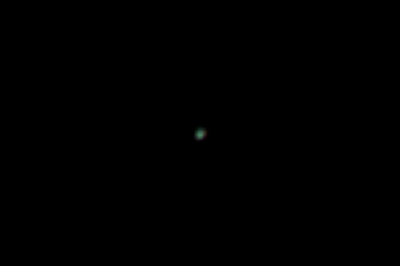
Much is said about how Earth is the "Blue Planet." There is even a well-known nature mini-series by that name. But Earth is not the only "blue planet" in our solar system. Another is Uranus. In the photo above, you can see the tiny blue fleck of Uranus to the upper left of Jupiter and its moons -- it was exposed specifically to reveal Uranus' color. (Click on the image for a better look.) Here is a close-up:

BTW, this makes seven -- the number of planets I have photographed. According to "Mary's Violet Eyes Make Joey Stay Up Nights -- Phooey!", I only have two left: Neptune and Pluto. Oh yeah, that's right: Pluto has been robbed of its planetary status. But I still think of it as a planet. How else could we give voice to Joey's crush on Mary? :-)


